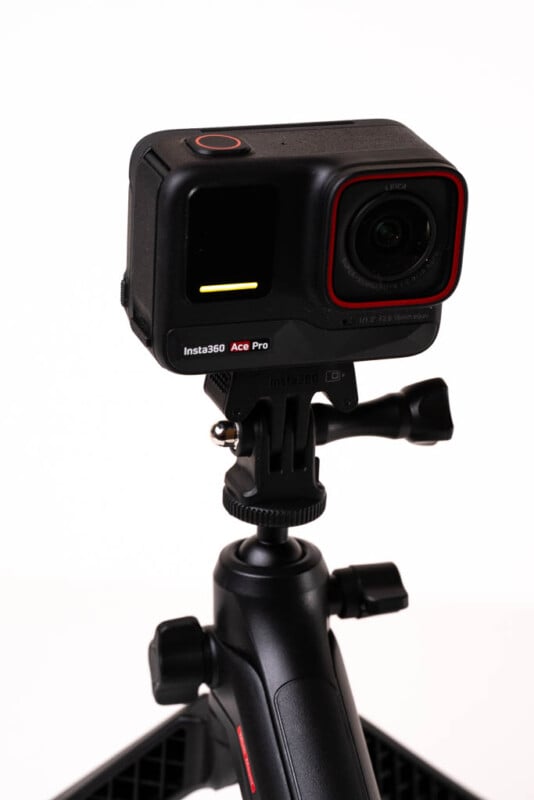Insta360 Ace Pro Review: An Impressive Action Cam with Added AI
![]()
As its name indicates, Insta360 is best known for its 360-degree cameras. The recent announcement of the Ace Pro is the company’s expansion into the more traditional form factor pioneered by GoPro and integrates some of the industry’s latest tech, including a high-end processor and large sensor. But is it enough to set this camera apart in the crowded action camera market?
Insta360’s Action Camera Competitor
While Insta360 isn’t entirely new to the action camera space, with previous offerings like the GO 3 and ONE RS having some way of being set up in an action camera format, it’s clear the Ace Pro is Insta360’s most deliberate attempt to target that market. This action cam style — with a rear screen, rugged housing, fixed wide-angle lens, and compact size — works well for many users.
GoPro is on its twelfth or so iteration, depending on how you count the various specialty models, while DJI has gotten into the mix with the Osmo Action line. All these cameras have converged on a similar form factor and price, giving buyers both a number of options and some important choices to make.
Insta360 launched two cameras in this line: the Ace Pro, which is the focus of this review, and the Ace. The Pro model is differentiated by a significantly bigger sensor and support for 8K video, along with USB-C PD Fast charging. Since the sensor and lens are crucial to a camera’s performance, only some aspects of the software and physical design critique can be applied to the non-Pro model.
Camera Design
Unlike the ONE RS, with its Lego-style interchangeability, the Ace Pro is instantly recognizable as a classic action camera. At 71.9mm by 52.2mm by 38.5mm (2.8 by 2 by 1.5 inches) and 180g (6.3 ounces), it feels solid without being too cumbersome to mount on yourself or your gear.

The back is entirely taken up by the flippable touchscreen, while the edges are home to the power button, shutter button, and hatches for the battery, USB-C, and MicroSD compartments. The front features a smaller monochrome status display, which can provide information about battery life, shots remaining, and the active mode. There’s also a status LED underneath that shows recording status, effectively functioning as a tally light.
Almost all functions are controlled by swipes on the rear screen. While not terribly difficult, this UI is a bit opaque to the user, and you’ll certainly have a tougher time handing this off to a friend and having them operate it. Adding a custom, remappable button to the top would go a long way to helping the UI.
The rear touchscreen measures 60mm or 2.3 inches diagonally. It is very sharp, although the combination of large bezels and the mismatched aspect ratio results in a smaller-than-expected viewable area. The on-screen UI is relatively minimal and can be hidden with just a tap, so the existing amount of space is put to good use. The UI can rotate when shooting vertically, and this behavior can be toggled.
The screen is locked to the back by two buttons, but can be released and flipped out to accommodate a top down view or even rotated 180 degrees for “selfie” mode. In selfie mode, it’s far easier to see framing and exposure compared to the smaller front facing displays on DJI and GoPro’s models.
On the front, the lens is protected by a front element that is not user-replaceable. Insta360 advertises” ‘free.. no questions asked’ Lens Guard repair,” but note that this is only for one year after purchase and requires the user to pay for shipping. Some competitors do offer a level of user-replaceable glass, like on the Action 4, so I’d love to see Insta360 offer something similar on future models.
Photo Quality
Action cameras are typically video-focused, but I’ve liked to use action cameras for photography in very inclement environments or for amateur underwater photography. With a 48-megapixel Type 1/1.3 sensor, support for DNG RAWs, and a Leica branded 16mm f/2.6 equivalent lens on front, the Ace Pro should be able to deliver good quality photos.
In practice, the photos look quite good for an action camera. Colors are punchy but skintones remain accurate. Daylight photos have excellent detail as long as the subject is at least a short distance away (more on this later). Nighttime photos aren’t perfect, but are among the best from an action or portable camera, thanks to the combination of a larger sensor and powerful processing courtesy of the cutting edge, 5nm chip.

The camera supports both 12 and 48-megapixel captures, a feature of the quad-Bayer sensor design that has never really impressed me for photography. Just like in previous cameras featuring this sensor, the bump from 12 to 48 megapixels is almost imperceptible, but the slower capture or larger file sizes are a clear negative. For capture speed alone, it’s worth just sticking to 12MP, where the camera delivers good quality results for the form factor.
It’s a similar story of tradeoffs for RAW captures, which you might prefer based on how you approach photography. There’s not a ton of latitude in RAW files and the JPEGs look great straight out of camera, meaning you’re probably best to stick with JPEG or PureShot photos for most scenarios. It’s only under tricky lighting conditions where white balance adjustment could make the difference that I’d choose RAW.

For the intended use of this camera, I’d consider the strong JPEG performance a plus — you can shoot and upload easily without first needing to edit to get everything out of your camera.
PureShot, essentially a combination of smart HDR, bracketing, and noise reduction, is also nice to have. Capturing in low light with PureShot can eliminate the need to manually noise reduce or exposure blend, and that’s a big plus for a compact camera.
Overall, the photos are pretty good, but they will still have the action camera “look” inherent to a smaller sensor and a very wide-angle lens. The wide fixed lens, along with focus fixed at a near-hyperfocal distance, limits both the risk of missing the shot and the opportunity to get particularly creative. Some slight crops are available in the camera, but you get a similar result overall.
Video Quality
Similar to the photo quality, the video experience is among the best for an action camera. The sensor and powerful processor really do combine to deliver stronger low-light results. Daylight shooting is great, but since so many cameras can deliver strong results in good conditions, I can’t give it too much credit.
The ability to shoot 8K and actually have it look good is an impressive feat, however. 8K clips, compared to 4K from competing cameras, genuinely offer more detail. There is a little bit of noise, and being limited to 24 frames per second when shooting in 8K could be a deal-breaker for some applications. However, even shooting beyond 4K in an inexpensive action camera shows how far technology has come.
Dropping to 4K opens the frame rate options to 120fps, a must-have for an action camera. Being able to shoot at 120fps and get great slow-mo is essential, as is having 30 and 60fps support for mixing the footage with other cameras. At 4K, the footage has great detail and is less overly-sharpened compared to some competing action camera — perhaps this is a benefit of downsampling from the 48mp sensor, or just a more conservative processing choice on Insta360’s part.
The dynamic range is great, with highlights being retained naturally. Stabilization is also very well done. Strong stabilization performance also helps the low light performance, as the combination of the big sensor, good stabilization, and effective noise reduction all leads to a very pleasing viewing experience in low light.
I was initially worried about the heat tolerance of the camera when recording long clips, given the high performance chip inside the compact frame. Fortunately, I never ran into any overheating issues, even when shooting extended clips or at high resolution.
For both vlogging and photography, one potential issue is the camera’s minimum focus distance. With a fixed lens, there’s always a compromise regarding how close the camera can focus, with the Ace Pro having a rated close focus distance of 0.4 meters or around 16 inches. Depending on how you want to vlog, you might be bumping right up against this limit. Using a diopter has helped some users address this, but there’s currently no good first-party solution.
AI Features
Insta360’s headline AI feature, AI Warp (which has since been launched for other cameras in Insta360’s lineup), is interesting in implementation. With either presets or custom keywords, your footage is post-processed via an AI effect, transforming your captured scene into a cyberpunk cityscape, lunar scene, or other setting. While it’s not really my shooting style, it’s certainly an innovative approach to “filtering” footage, particularly for users looking for a wow factor for friends on social media. This isn’t processed in camera, however, and relies on the user to roundtrip footage through Insta360’s app. A brief sample can be seen in the timestamped launch video above.
Alternatives
Both GoPro and DJI produce models that compete in the same space, with the Action 4 from DJI being clearly the closest competition.
Compared to the Action 4, the Ace Pro offers better image quality, a flip screen, and some additional features via the app for highlight selection and even AI post-processing. The Action 4’s biggest feature, in my opinion, is a user-replaceable front glass element, along with a lower effective price.
Should You Buy it?
If you’re looking for a versatile action camera that delivers quality footage, the Ace Pro is a great option. Vlogging, low light, 8K shooting, and creating content without the need for heavy editing are all great applications for this camera.
Users who are really going to push the camera physically, however, might want to consider the Action 4, as the replaceable front element and non-flippable screen could help the camera resist wear and tear better. Plus, the slightly lower price could make an eventual total-loss event sting a little less.
Overall, I’m impressed by Insta360’s entry into the market. While the Ace Pro doesn’t reinvent the action camera, it instead executes all the features at among the highest levels. The Ace Pro is available at Adorama.